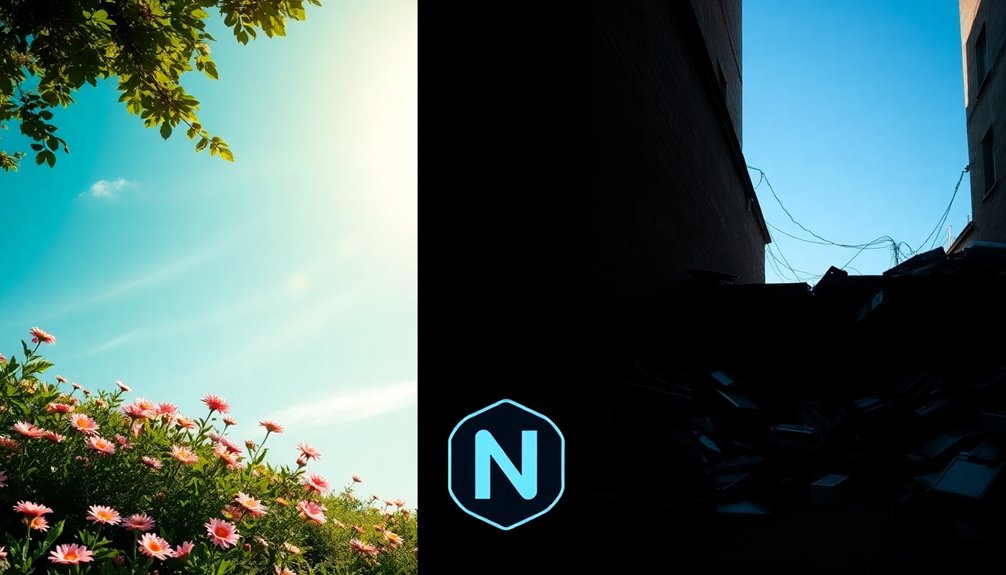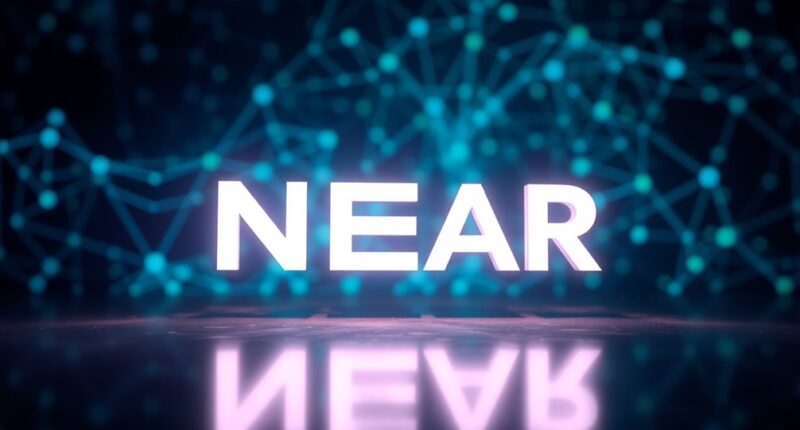NEAR Crypto is a next-generation blockchain platform designed for high performance and ease of use. It supports decentralized applications with remarkable speed, processing over 100,000 transactions per second using its unique sharding mechanism called Nightshade. With features like the Rainbow Bridge, you can easily transfer assets between NEAR and Ethereum networks, enhancing cross-chain compatibility. The platform's user-friendly interface and support for multiple programming languages make it accessible to developers. While it boasts impressive scalability, some concerns about governance and market volatility exist. To understand more about NEAR and its capabilities, keep exploring its impressive features.
Key Takeaways
- NEAR Protocol is a scalable blockchain platform designed for user-friendly decentralized applications (dApps) and high transaction throughput.
- It utilizes a unique sharding mechanism called Nightshade, enabling up to 100,000 transactions per second.
- NEAR employs Proof of Stake for consensus, ensuring energy efficiency and enhanced security in transaction processing.
- The Rainbow Bridge allows seamless asset transfers between NEAR and Ethereum, promoting cross-chain compatibility.
- NEAR's ecosystem supports multiple programming languages and offers extensive developer resources for building and deploying dApps.
Core Concepts of NEAR

At its core, NEAR Protocol is designed to enhance blockchain scalability and usability through innovative mechanisms.
One key feature is its sharding mechanism, which partitions the network into smaller shards that can process transactions and execute smart contracts independently. This parallel processing increases transaction throughput, making NEAR ideal for high-demand applications. Additionally, NEAR's architecture supports high transaction throughput, further reinforcing its capacity to handle large user bases efficiently.
Additionally, NEAR employs the Nightshade consensus mechanism, which enhances security and scalability through validator assignment across shards.
With its focus on interoperability, the Rainbow Bridge allows seamless asset transfers between NEAR and other blockchains like Ethereum.
Together, these core concepts create a robust environment, empowering developers to build efficient decentralized applications while ensuring a user-friendly experience and cost-effective transactions.
Overview of NEAR Protocol

NEAR Protocol stands out in the blockchain landscape for its unique architecture that prioritizes scalability and user experience.
It features a blockchain layer responsible for managing transactions and accounts, while the independent runtime layer executes those transactions based on smart contract rules. This separation allows for greater flexibility and scalability.
NEAR employs Nightshade sharding, which divides the network into chunks to enhance transaction throughput, enabling it to handle up to 100,000 transactions per second with instant block creation. Additionally, NEAR's sharded proof-of-stake architecture ensures that the network remains efficient and scalable as it grows.
Using a Proof of Stake consensus mechanism, NEAR ensures energy efficiency while maintaining a unified data chain for integrity.
With robust developer tools and cross-chain compatibility, NEAR makes it easier for you to build decentralized applications and engage with the blockchain ecosystem.
Transaction Execution Process

While engaging with NEAR Protocol, you'll find that the transaction execution process is designed to be efficient and user-friendly.
It all starts when you initiate a transaction using tools like near-shell. The transaction is hashed and signed with your secret key, creating a 'SignedTransaction' object. Your account balance is then checked to ensure it can cover the transaction costs. Additionally, you must ensure that you have enough tokens to cover the token balance required for on-chain data storage.
After signing, you submit the transaction to a NEAR Protocol node via RPC, choosing between synchronous or asynchronous submission. The network validates your transaction, checking its signature and balance.
Once validated, it turns into a 'Receipt.' This receipt undergoes processing where the actions are executed, and your transaction achieves finality once all actions are completed and included in the blockchain.
Pros and Cons

Understanding the transaction execution process gives you insight into NEAR Protocol's functionality, but it's equally important to weigh its pros and cons.
On the plus side, NEAR offers remarkable scalability, processing over 100,000 transactions per second with minimal fees. Its interoperability and user-friendly features enhance usability, attracting developers and users alike. Furthermore, NEAR's unique scaling solutions like Doomslug and Nightshade set it apart from many competitors in the blockchain space.
However, governance issues raise concerns about centralization, as only validators can vote on changes. Additionally, NEAR faces stiff competition from established blockchains and struggles with lower global adoption.
Technical complexities, including potential inflation and the risk of 51% attacks, add to the uncertainty. Lastly, market volatility presents economic risks, making it essential to stay informed before investing.
NEAR vs. Ethereum Scalability

When comparing scalability, NEAR and Ethereum take different approaches that significantly impact their performance and user experience.
NEAR employs sharding technology, which divides the network into parallel chains, allowing it to handle a high volume of transactions with fast confirmation times of just two to three seconds. This linear scalability reduces congestion and lowers transaction fees. Additionally, NEAR's threaded runtime facilitates parallel execution of smart contracts, further enhancing its efficiency.
In contrast, Ethereum relies on Layer-2 solutions like rollups, which can still face congestion during peak times and have longer exit times. While Ethereum prioritizes a simple Layer 1 protocol, NEAR's native composability enables seamless cross-shard interactions, enhancing the developer experience.
Ultimately, NEAR's architecture presents a more efficient, user-friendly solution for scalability than Ethereum's rollup-centric model.
Market Volatility Concerns

Market volatility is a significant concern for NEAR and other cryptocurrencies, especially as new participants enter the space.
The ongoing price discovery phase means fluctuations can be drastic as consensus on value is established. Limited supply can lead to sharp price movements, particularly when large holders, or whales, make significant trades. This is even more pronounced in smaller market cap assets. Moreover, the high volatility characteristic of the crypto market often leads to unpredictable price swings.
Additionally, the lack of clear regulations globally adds another layer of uncertainty, with sudden changes impacting prices dramatically. Economic conditions and institutional involvement also play crucial roles, often exacerbating volatility.
Until the market matures and mainstream adoption grows, you can expect heightened instability in cryptocurrency prices, including NEAR.
Ecosystem Partnerships Expanding Rapidly

As NEAR continues to grow, its ecosystem is rapidly expanding through strategic partnerships that enhance its capabilities and offerings.
Collaborations like the one with Nansen provide real-time data to help you understand transaction patterns and wallet activity. This integration supports both developers and investors by bringing transparency to the web3 space. Additionally, NEAR's partnership with Nillion Network boosts privacy solutions, implementing blinded computing to handle sensitive data off-chain. The entry of Deutsche Telekom's subsidiary into the ecosystem solidifies its commitment to decentralization, while collaborations with firms like SpaceNerds aim to improve data storage and security.
Furthermore, Nansen's role in enhancing real-time analytics is expected to empower the developer community and attract more investors to the NEAR ecosystem. Together, these partnerships are driving innovation and scaling NEAR's ecosystem to meet future demands.
Utilize Near's Developer Resources

To effectively build on the NEAR blockchain, you can tap into a wealth of developer resources designed to streamline your experience.
Start with the official documentation at [docs.near.org] for comprehensive guides and user docs. If you're looking for protocol specifications, head over to [nomicon.io]. Additionally, you can leverage the NEAR Developer Documentation for in-depth insights into the architecture and features of the platform.
Utilize tools like 'create-near-app' for deploying fullstack dApps and 'cargo-near' for smart contracts. Engage with the community in real-time via [near.chat] for support.
Explore the Beginner's Guide for foundational knowledge, and check out example applications at [github.com/near-examples].
Frequently Asked Questions
How Can I Buy NEAR Tokens?
To buy NEAR tokens, start by creating an account on a cryptocurrency exchange like Bybit or Uphold.
Verify your account through the KYC process and choose your payment method, such as credit or debit cards.
Once you've funded your account, select the option to buy NEAR tokens.
After confirming your purchase, transfer your tokens to a secure wallet for safekeeping.
Keep your wallet updated and secure to protect your investment.
What Wallets Support NEAR Cryptocurrency?
You might think that choosing a wallet is overwhelming, but it's simpler than it seems.
For NEAR cryptocurrency, you can use options like MyNearWallet, which offers secure storage, staking, and access to dApps.
Trust Wallet is another choice, focusing on user-friendly features.
Both wallets ensure you maintain control over your assets.
Consider your needs for security, usability, and features to find the perfect fit for managing your NEAR tokens effectively.
Is NEAR Crypto Environmentally Friendly?
Yes, NEAR crypto is environmentally friendly. It uses a Proof-of-Stake consensus mechanism, which is far more energy-efficient than traditional systems.
With its impressive capacity to process 1,000 transactions per second and minimal carbon footprint, it stands out in the blockchain space.
NEAR also offsets its emissions through reforestation projects, ensuring it's certified as climate neutral.
You can feel good knowing your involvement contributes to a sustainable future for blockchain technology.
Where Can I Track NEAR Price Trends?
Imagine a compass guiding you through the crypto wilderness. To track NEAR price trends, you've got several reliable options.
Check out Crypto.com or CoinMarketCap for live updates. Platforms like CoinGecko and CoinStats offer detailed market insights, too.
For community vibes, dive into NEAR Collective or forums. Set price alerts on your favorite trading app, and you'll always be one step ahead in this ever-changing landscape!
What Is the Future Outlook for NEAR Crypto?
The future outlook for NEAR Crypto looks promising.
You'll see scalability enhancements through sharded proof-of-stake technology and the Nightshade consensus protocol, boosting transaction speeds.
As the ecosystem develops, user-friendly tools will simplify dApp interactions, making it easier for you to engage.
Plus, NEAR's interoperability will allow seamless communication with other blockchains.
With growing interest from developers and potential mainstream adoption, you can expect exciting advancements ahead in this space.
Conclusion
In the world of blockchain, NEAR Protocol stands out like a lighthouse guiding developers through turbulent waters. With its impressive scalability and user-friendly features, it's clear that NEAR isn't just another player; it's a game changer. As you explore its ecosystem and harness its resources, you'll find a vibrant community ready to support your journey. Embrace the future of decentralized applications with NEAR, and watch your innovations flourish like seeds in fertile soil.









